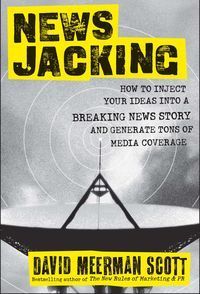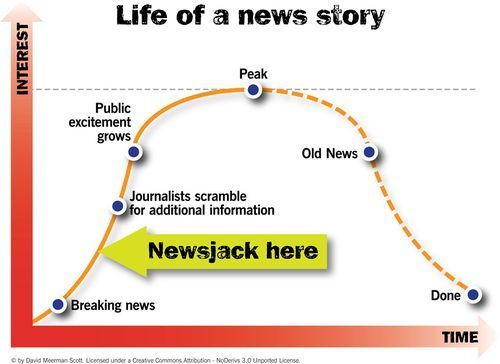David Meerman Scott's Blog, page 87
March 12, 2012
Tough love for marketing and PR job seekers
Are you a marketer or PR pro looking for a job?
Prepare for a reality check.
What happens if I Google the name on your resume and the most recent company you worked for?
When I am asked to vet a candidate for one of the companies I am associated with, the first thing I do is head to Google and see what content appears. And that's what I suggest potential employers do.
On the Web, you are what you publish
Sadly, for many job seekers, what pops up on Google are a few random things (like your membership in the company softball league), your LinkedIn profile, and not much else. Sometimes there is a Twitter feed but frequently it was started years earlier and has been abandoned or it's only updated a few times a month.
With more senior people, I always laugh when the top content when I Google your name is the press release that your company issued a few years earlier to announce you are joining.
Today's marketing and PR is about content creation. Your personal brand is also about content creation.
If you don't care enough to build your personal brand then why should a company employ you to create a brand for them?
On Saturday at #SXSW, I met with my good friend Jon Ferrara (@jon_ferrara) who is the CEO of Nimble. Jon told me that he has a position open for a senior-level marketer and wanted to get my advice on the sort of person he should hire.
I told Jon to never look at a resume. Just delete it. Instead, administer the "Google test." We agreed that eliminates nearly all candidates from consideration.
People like Jon look for potential hires who are very active on social media and creating content. Jon and the other CEOs and senior executives I work with are not looking for professional managers. They are not looking for agency wranglers. They are not looking for talkers, they are looking for doers. They want marketers (even at the senior level) who are passionate about creating content on the Web.
Insisting on a positive result for the "Google test" makes it tough for CEOs like Jon to find qualified people, but greatly increases the chances that the marketer who ends up getting hired will be a good fit for achieving the company's goals. Jon told me that anyone who wants to be his top marketer needs to be at least as successful on social networks as he is. Seems reasonable to me!
Prove you are a great marketer
The good news is that you can fix the problem that eliminates you from consideration for the hottest jobs.
You need to show, don't tell. You need evidence that you are passionate about your personal brand. You need to create content. Now. Starting today.
There are a bunch of things you can do, starting today, that might include some of the following: You could start a blog, create a YouTube channel, or tweet more than a few times a month. You could create an infographic about the industry you want to work in or your particular area of expertise. You could get active on some newer channels like Google Plus, Instagram and Pinterest so you can speak intelligently about them. You could sit on panels at events like SXSW and have people in the audience talk about you on social channels. These are just a few examples.
I've delivered this advice to hundreds of people. Sadly for them, I know from experience that 90% of people ignore this advice.
Will you be in the 10%?
I am convinced if you are a job seeker, you need to pay attention to this tough love.
Bonus for reading this far: People who get really clever with this strategy then target companies they want to work for and create content (a blog post or video for example) that relates to that company. Perhaps a suggestion for how that company can do something different. You want to get noticed by the marketing department of your target company? Forget sending a resume. Instead create something interesting and publishing it on the Web. Your potential hiring manager will be eager to consume your work and you brand yourself as a player.
March 7, 2012
Neil deGrasse Tyson as master communicator
 I'm a big Neil deGrasse Tyson fanboy.
I'm a big Neil deGrasse Tyson fanboy.
Partly that's because I'm an Apollo moon mission geek and collect artifacts from the Apollo program. (Pretty geeky, right?)
But mostly, I'm a fan because Dr. Tyson is such an awesome communicator. When I read his books and articles or watch him on television, I always take away something that I can apply to my own work as a marketer and communicator.
His bio says Neil deGrasse Tyson s an astrophysicist and the director of the Hayden Planetarium in New York City. But he is so much more.
Neil deGrasse Tyson as master communicator
Dr. Tyson is so good at speaking and writing about the cosmos and why it is important for us to have an understanding of the wider world in which we live.
If you haven't heard him speak, check out Jon Stewart interviewing Dr. Tyson on The Daily Show on February 27, 2012.
In the clip, he explains how fear contributed to the development of America's space program in the late 1950s, thereby spurring economic growth. "We no longer advanced a space frontier," he says. "The Space Shuttle boldly went where hundreds have gone before." Watch the clip to see a master communicator at work.
By the way: An astrophysicist with 350,000+ followers on Twitter? What's up with that? Yep, that's @neiltyson
Space Chronicles
 His newest book, just out, is Space Chronicles: Facing the Ultimate Frontier – a collection of essays and speech transcripts around the theme of space exploration and how America & NASA has not done much to inspire people in the past 40 years outside of some cool robotic missions and the Hubble telescope.
His newest book, just out, is Space Chronicles: Facing the Ultimate Frontier – a collection of essays and speech transcripts around the theme of space exploration and how America & NASA has not done much to inspire people in the past 40 years outside of some cool robotic missions and the Hubble telescope.
I read Space Chronicles in three sittings because it is that good.
In the book, he talks about how America boldly embarked on the most audacious scientific endeavor in history by sending humans to the moon. However after 9 lunar missions (6 that landed) we... stopped exploring! For 40 years we've only been to low earth orbit with manned missions.
Sure there have been some spectacular robotic missions such as Cassini to Saturn and the various Mars rovers. And the Hubble space telescope has delivered spectacular images. But humans haven't explored.
Dr. Tyson argues we're not inspiring our young people to study science and engineering and that's a problem for the economy.
"Absent such curiosity, we are no different from the provincial farmer who expresses no need to venture beyond the county line, because his forty acres meet all his needs. Yet if our predecessors had felt that way, the farmer would instead be a cave dweller, chasing down his dinner with a stick and a rock."
- From Space Chronicles.
If you want to see how thought leadership is done by a master communicator, read and watch the work of Neil deGrasse Tyson. You don't need to agree with him nor be a space geek to learn from his style.
Quick aside – In high school my buddies and I would go to the Hayden Planetarium (after some appropriate preparations of course) to see evening productions of "Laser Floyd" – a cosmic mixture of loud Pink Floyd with colorful lasers projected on the planetarium dome. I've even got a ticket stub from 1978 to prove it. Neil is close to my age. He grew up in New York City. I wonder if he went too? Nah, probably not. He was studying while I was partying. But maybe?!
Image: from @neiltyson Twitter.
March 6, 2012
President Obama Newsjacking Republicans on Super Tuesday
 This afternoon, Tuesday March 6, 2012, President Obama held his first solo news conference from the White House since October 6, 2011.
This afternoon, Tuesday March 6, 2012, President Obama held his first solo news conference from the White House since October 6, 2011.
His choice to answer journalists' questions on Super Tuesday, when voters in ten U.S. states vote in the Republican Presidential Primaries (arguably the most important date of the entire primary season) is a classic example of political newsjacking.
So in today's online news stories, this evening's television and radio broadcasts, and tomorrow's newspapers, the Republican Super Tuesday winner(s) need to share the top story with the President.
The president has engaged in newsjacking before. For example: President Obama Newsjacks Iowa Caucus by joining Instagram.
You can newsjack too
It's not just the President who drafts off the Republican challengers for the White House. Anybody can do it if they can find an appropriate angle to create some content around some angle in real-time.
For example, when candidate Rick Santorum commented about homeschooling, it gave homeschooling expert Christa Johnson an ideal opportunity to respond on her blog: There Isn't One Face of Homeschooling.
President Barack Obama speaks during a news conference in the James Brady Press Briefing Room of the White House in Washington, Tuesday, March 6, 2012. Photo: Screen grab from WhiteHouse.gov live streaming feed.
March 5, 2012
Boeing 787 Dreamliner and airline passenger choice
Yesterday I was a guest of Boeing Commercial Airplanes on a preview tour of the brand new Boeing 787 Dreamliner.
The 787 test aircraft was at Boston's Logan Airport because it is scheduled to be the first US airport with regular 787 commercial service with a nonstop Japan Airlines flight to Tokyo.
In this short video, I speak with Capt. Randy Neville, chief pilot, 787 program, Boeing Commercial Airplanes and Diana Klug, Director of Marketing for Boeing Commercial Airplanes. We tour the new Boeing 787 Dreamliner cockpit and cabin and I focus on passenger comfort including the large windows and customizable LED passenger compartment lighting.
Direct link to Boeing 787 Dreamliner preview tour video on YouTube.
This airplane is terrific. The passenger compartment is higher than other passenger planes and that gives it a less claustrophobic feel. The large windows with a dimming feature (see the video) means that there is no longer "up or down only" like with normal shades and there is no need for sunglasses if you want to look for icebergs on the return day flight from Europe in the winter sitting on the right side of the plane.
 It's exciting that my home airport will now have nonstop service from Boston to Tokyo on Japan Airlines. I've had a primary US residence in Massachusetts for more than 20 years and for 7 of those years I lived in Tokyo. The hassles of switching planes vs. a 14-hour nonstop are enormous.
It's exciting that my home airport will now have nonstop service from Boston to Tokyo on Japan Airlines. I've had a primary US residence in Massachusetts for more than 20 years and for 7 of those years I lived in Tokyo. The hassles of switching planes vs. a 14-hour nonstop are enormous.
Boeing actually worked with a psychologist and a cultural anthropologist and conducted many interviews with frequent flyers to design the plane the 787 Dreamliner from the passenger perspective, thinking that people will book travel based on the plane.
That's exactly what I do (and what other frequent travelers do too). When you're in the air as often as I am comfort is the most important thing -- more important than price, special deals, and other things.
But I wonder how many people would choose based on the airplane? It seems most casual flyers choose on price. Business travelers often choose based on schedule.
 Fun aside. When I was taking a photo of the 787 Rolls-Royce engine turbine that I posted to Instagram, the Boston Globe was photographing me in an image that was published here.
Fun aside. When I was taking a photo of the 787 Rolls-Royce engine turbine that I posted to Instagram, the Boston Globe was photographing me in an image that was published here.
PR thought: What better PR asset than a beautiful airplane with articulate pilots and marketing staff to explain it. Great job @Boeing and @BoeingAirplanes.
What would you do?
So what would you do? Given a choice between variables like price, schedule, an airline that you have a frequent flyer account with, and number of stops, what are the most important factors for you? Would you choose to fly the 787 Dreamliner for the experience?
March 2, 2012
Attention Creatives! Enter the UrgentGenius Newsjacking competition this weekend
 My friends over at UrgentGenius have just kicked off the second annual Newsjacking competition and you are invited to enter.
My friends over at UrgentGenius have just kicked off the second annual Newsjacking competition and you are invited to enter.
But you've got to act fast because the contest starts today and you only have this weekend to create something awesome.
Hey, it's real-time stuff we're talking here – so it's a real-time contest.
The brief is simple
The challenge is open to advertising and PR folk, coders, students, filmmakers, bedroom mash-up experts, and, well, YOU.
Just choose a trending topic and create a reaction to it in the space of 48 hours.
But you've got to register first.
 Anything goes, as long as it's topical. Just think, make and launch. Your content could be a blog post, an infographic, a video, a flashmob that you film, a Facebook game. Whatever you want.
Anything goes, as long as it's topical. Just think, make and launch. Your content could be a blog post, an infographic, a video, a flashmob that you film, a Facebook game. Whatever you want.
The team that creates the content with the most hits / likes / retweets wins. In addition, UrgentGenius has "a who's who" (their words) of media folk to appraise the work so even if your creation doesn't win, it could be a "judges favourite." (I'm one of the judges.)
Up for the challenge? Submit your team NOW.
TIMELINE:
Today, Friday March 2 at 6:00 pm in your local time zone the competition begins. You've got just 48 hours to create some awesome content.
On Sunday March 4 at 6:00 pm in your local time zone the competition ends and your content needs to be complete and posted.
Between March 4 and March 11 you seed people to react – to tweet, like, link, +1, and other ways - to show people are interested in your creation.
During South-by-Southwest - SXSW - interactive festival I'm speaking on Newsjacking and the UrgentGenius team are involved in several panels. We'll be talking about the entries from the stage.
On March 11 UrgentGenius tallies the results and declares a global winner
Buzz generated for the winners
The best creations will be included in talks by Urgent Genius founders Jon Burkhart and Grant Hunter at SXSW Saturday March 10 at 11:00
Real-Time Newsjacking & a Cold-Blooded Tweeter
I'll be talking it up at my Newsjacking presentation at SXSW too on Friday March 9 at 2:00
Newsjacking: How to Inject your Ideas
Last years' Urgent Genius Weekender resulted in content featured everywhere from PerezHilton.com to Rolling Stone, the Guardian, Empire and MTV with the best stuff gathering more than 2 million cumulative hits.
February 29, 2012
How to create and edit articles for Wikipedia
 Wikipedia is among the top ten most visited sites on the Web. When there is a Wikipedia article on a topic that you search on, I'm sure you've noticed that article usually appears as one of the top few results, frequently in the number one position.
Wikipedia is among the top ten most visited sites on the Web. When there is a Wikipedia article on a topic that you search on, I'm sure you've noticed that article usually appears as one of the top few results, frequently in the number one position.
There's no doubt that Wikipedia is important.
However there are few people who understand the inner workings of Wikipedia and how the more than 3.8 million articles in the English language (and millions more in 282 other languages) are created.
Sure, Wikipedia is an open platform and anybody can create or edit an article. But it's more complicated than that. A lot more complicated.
 I asked my friend Colin Warwick to help us out. Colin is a Product Marketing Manager at Agilent Technologies. He writes the popular Signal Integrity blog and tweets at @SignalIntegrity.
I asked my friend Colin Warwick to help us out. Colin is a Product Marketing Manager at Agilent Technologies. He writes the popular Signal Integrity blog and tweets at @SignalIntegrity.
David: How did you get interested in contributing to Wikipedia?
Colin: "Around 2004, a colleague at MathWorks - Ned Gulley - gave a talk on the crowdsourcing phenomenon: What it was, why it was happening, and Wikipedia was his prime example. His point was the success of Wikipedia is surprising. How can a bunch of unmanaged volunteers compete with the resources of, say, Microsoft (who had Encarta at the time) or the venerable Britannica. There's that famous quote: 'The problem with Wikipedia is that it works in practice, but not in theory'."
David: So why does it work then?
Colin: "It's true that a naive application of a theory like the tragedy of the commons would predict failure. But in the case of Wikipedia we get the inverse outcome because the cost of a contribution is much less than its value over time. For example, it costs very little for a contributor to enter knowledge from their experience into the servers, and very little for Wikipedia to serve that information over and over again to readers, generating great value over time. Unlike the pasture of a physical commons, information isn't degraded much by use. So the value of Wikipedia increases over time attracting more readers, some of whom become contributors, forming a virtuous cycle."
David: So you got sucked into the vortex?
Colin: "Yes. I became intrigued and started to add little facts I found here and there. The interaction with other contributors was startling at first but I began to realize that in questioning my assumptions I was not only contributing but pushing my own understanding to a higher level."
David: Give us an example.
Colin: "In my work, I had to learn about a new technology we wanted to enter called ODB++. I started researching it and gathered and read a ton of web links. But I noticed there wasn't a Wikipedia article about it. So I started one."
David: Just like that?
Colin: "Just like that. The best way to start or add to a Wikipedia article is to gather good web links first. Web-based versions of newspaper and magazine articles. Books. In Wikipedia-speak, it's called reliable sources."
David: What about blog posts and other social media?
Colin: "Ironically for a user-generated content site, Wikipedia looks down on user-generated content. Blogs can be a reliable source if the blogger is notable for something other than blogging."
David: Interesting. I didn't know that before speaking with you. So what happened next?
Colin: "Other editors started contributing to the article as I was writing it. At first it was really irritating to have some unknown person editing 'my' article as I was writing."
David: Wasn't it your article?
Colin: "Technically, no. If you contribute to Wikipedia, you irrevocably agree to release your contribution under the Creative Commons license. And they warn you 'If you do not want your writing to be edited, used, and redistributed at will, then do not submit it here'."
David: That seems harsh. So what's the value for contributors on Wikipedia if that's the case?
Colin: "Well, once I got over the irritation, I began to see a benefit: I learnt whole new perspectives from the other contributors that I didn't even know existed. There's a discussion page behind every article where you can ask: 'Why did you delete what I wrote?' It's kind of addictive. Who's going to end up right or wrong or what compromise will be reached? You can see why Wikipedia contributors give each other virtual barnstars as a token of appreciation in at those moments. It's evocative of communal barn building in certain rural communities. I had my barn-building moment on that article!"
David: The article you wrote wasn't directly about your company. Many people want to know if they can create an article about their own company or its products and sevices. I'm asked that a lot. Can you do that?
Colin: "You can but it's very difficult to not run afoul of Wikipedia's conflict of interest rules, COI in wiki-speak. Other editors can smell marketing puffery a mile way and will delete it as advertising in a heartbeat. The only workaround is to put Wikipedia's goal of a neutral point of view (NPOV in wiki-speak) first, and then either proactively seek what's called a COI review, or simply let nature take its course. As with all articles, you have the best chance of your edits 'sticking' if you come armed with reliable sources: don't simply add your opinion."
David: Cool. Finally after many years of using Wikipedia I feel like I know a little about how it is put together and how someone in business can benefit from contributing. Hey Colin, you should write a book about all this stuff.
Some smart editor or publisher who is watching this blog should cut a deal with Colin to do a book.
February 27, 2012
Brilliant Newsjacking alert - The Artistifier
 My friends over at Urgent Genius released a terrific little application last night during the Academy Awards called The Artistifier.
My friends over at Urgent Genius released a terrific little application last night during the Academy Awards called The Artistifier.
The Artistifier allows you to turn any YouTube video into an "award-winning" silent movie in the style the Oscar-winning film The Artist. You can even add your own captions before sending your finished black and white masterpiece via Facebook and Twitter.
I turned one of my speaker videos into Artist-style and it is really cool.
Fun with Newsjacking
This is a terrific example of Newsjacking. The idea of taking something that is being talked about in the news and drafting off of it in order to get media mentions and social sharing is a fantastic strategy for real-time PR.
However, the vast majority of PR people are still in campaign-only mode. They focus on what's important to them and not what's important to the media and the public. If you think in real-time and create content that is valuable for the moment you can use Newsjacking to get ink and shares. Sometimes you can get a lot.
If you're going to the South-by-Southwest interactive festival in March, you can hear me speak about Newsjacking. Stop by and say hello.
SXSW Friday March 9, 2012 at 2:00
Newsjacking: How to Inject your Ideas
In addition, the team behind The Artistifier will be at two SXSW panel discussions:
SXSW Saturday March 10, 2012 at 11:00
Real-Time Newsjacking & a Cold-Blooded Tweeter
Monday March 12, 2012 at 12:30
The Not So Allied Forces of Social TV Comedy
February 26, 2012
My second favorite Super Bowl ad of all time
Last night I had dinner at my friend Brian Halligan's place. Brian is CEO of HubSpot and my co-author on our book Marketing Lessons from the Grateful Dead: What Every Business Can Learn from the Most Iconic Band in History.
Also at dinner was Joe Grimaldi, CEO of Mullen. We got to talking about my second most favorite Super Bowl ad of all time, which was created by Mullen Advertising: When I Grow Up (1999) for Monster.com.
This commercial tells a powerful story. It doesn't talk about the product directly. Yet there is no mistaking what the benefits of the product are even though they are not spoken. The spot uses humor but in a powerful way. It is memorable.
Ever since I first saw the ad in 1999, keep coming back to it as a model of what a good Super Bowl ad can be.
Others agree because "When I Grow Up" makes most "top" lists such as the number 18 spot on this 100 Greatest Super Bowl Ads Ever list.
Another sign of respect is that the ad has had dozens of parodies made of it. This one When I Grow Up I Wanna Work in Advertising is particularly good.
Don't talk about the product.
Okay, so what's my number one most favorite Super Bowl Ad? It's Tabasco Mosquito from 1998. I spat up my beer when I saw it live. And I've watched it on YouTube dozens of times. It just works in all the ways that the Monster.com ad does. And it uses humor with no words spoken at all.
Ads like these get talked about.
The ongoing PR value, even a decade later, makes producing them worthwhile. I'm generally not a fan of big-budget ads, but with work like these, I make exceptions.
February 23, 2012
Newsjacking via a real time Kindle book
 Here's a new book you can get on your Kindle: Linsanity: The Improbable Rise of Jeremy Lin
Here's a new book you can get on your Kindle: Linsanity: The Improbable Rise of Jeremy Lin
What?! Jeremy Lin has been the hottest sports story for less than two weeks and there's already books about him?
Welcome to the new world of Newsjacking via Kindle.
This book is by Alan Goldsher and according to a Fast Company author interview with him, it took 72 hours to write a 15,000-plus-word manuscript, 36 hours using Vook technology to build the e-book, and then another 24 hours to arrange distribution.
And now we're not only talking about Lin the basketball player, we're also talking about Lin the book and about author Alan Goldsher.
Newsjacking
 Whenever there is a hot story in the news, there is an opportunity to create and publish original content that the media will find and will get you coverage.
Whenever there is a hot story in the news, there is an opportunity to create and publish original content that the media will find and will get you coverage.
Newsjacking can be by writing a blog post, doing a YouTube video, creating an infographic, or even publishing a book on Kindle.
Business-to-Business and Nonprofits too
In B2B markets, I'm imagining a scenario where a new regulation hits an industry and some smart person does a speedy analysis of what it means for the industry and publishes that as a Kindle book.
Or in the nonprofit world, a natural disaster strikes and people are looking for how to help the victims and how to protect themselves in the future.
Write the book quickly and get it out fast. Then blog it, tweet it, and send a media alert about it.
The Newsjacking aspect comes in because the media, looking for background on a story, may read and then cite the book in their stories on the new regulation.
Newsjacking is cool. It's fun. And it gets you ink!
A hat tip to Tony Faustino who alerted me to this story. Hey Tony, you newsjacked the story of the Kindle newsjack of Jeremy Lin. Nice work!
February 20, 2012
Great service as lead generation
When you provide superior service, people talk about you online and that drives new business.
I caught up with my good friend Doug Weil recently. We used to work together in Tokyo in the 1990s. Like me, Doug moved back to the USA and now runs his own business.
 Doug's business, Clearly Resolved, provides video calibration services to customers throughout the Midwest. Video calibration is the art and science of adjusting high-end video displays (such as those used in home theaters and sports bars) so that the on-screen image matches original source content. When a video system is properly calibrated, the image looks just like in a movie theater or ballpark or concert stage. If not, the colors can be out of whack, sometimes dramatically, because factory settings are optimized for showroom floors and are typically way too harsh.
Doug's business, Clearly Resolved, provides video calibration services to customers throughout the Midwest. Video calibration is the art and science of adjusting high-end video displays (such as those used in home theaters and sports bars) so that the on-screen image matches original source content. When a video system is properly calibrated, the image looks just like in a movie theater or ballpark or concert stage. If not, the colors can be out of whack, sometimes dramatically, because factory settings are optimized for showroom floors and are typically way too harsh.
A proper professional calibration requires expertise, equipment, and several hours. Since starting his business in 2002, Doug has calibrated over 1,500 systems.
Lead Generation
I asked Doug about how he generates new business.
Turns out many people find him through the reviews that his happy customers post on video and home theater forums and blogs such as this one in AVS Forum (scroll down to read the review).
Because Doug provides superior service, his reviews are excellent, driving people to seek him out.
It seems so simple.
Provide excellent service and people will talk you up.
But there's one more step. Make sure that your business is listed in appropriate places where people will look once they hear of the great work you do. For Doug, that means his listings in ISF Forum and other similar places. Note his Clearly Resolved listing and how he provides excellent content describing who he is, especially his bio description of how he was bitten by the video bug.
Are you providing great service? And when you do, are you making it easy for people to find you and providing the content that gets them to reach out to you?




